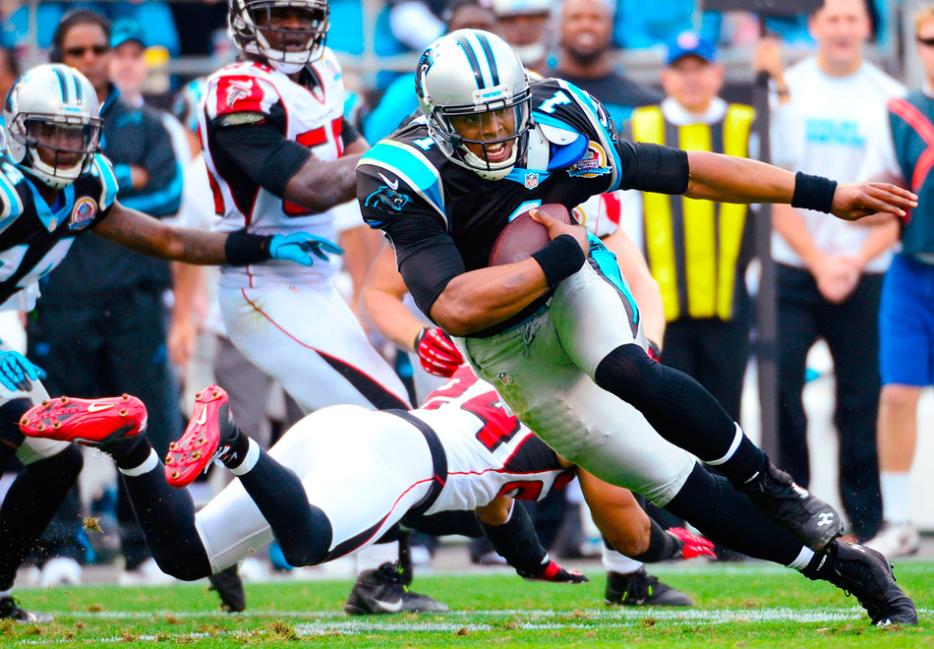On the list of opinions that are actually basement furniture—old, tired bits you don’t have the heart to eliminate but to which you only resort when you’ve run out of other options—the most prominent sports-related one is that baseball is boring. To sate the 14,000 blazer-wearers whose sphincters just instinctually opened their Twitter apps: I think that’s untrue, not to mention worn out. The sport that really is boring, of course, is football.
Where baseball has a patient subtlety in strategy punctuated by impressive bursts, football is a 14-volume encyclopaedia of tactics and techniques that all amount to, basically: outrun that dude. (Sometimes: out-jump that dude, or kick that ball far.) It’s like combining two cities’ orchestras for a rendition of “Chopsticks.” Football is also a fundamentally disjointed game, lacking the fluidity of hockey or soccer or even rugby, staccato bursts of largely monotonous effort—a three-yard run is the “red” of football’s roulette wheel—interrupted by expansive stretches of people standing and yelling or crouching and sweating. Competitive eating contests have more sustained action and slightly fewer chubby guys grunting.
The easy, defensive response to the grumbling is, naturally, that football is the most popular sport in America (and the third-most popular as well, if you divide it into professional and college) and reasonably far up there in Canada, too, a behemoth that takes over five months’ worth of Sundays (and sometimes Thursdays and Fridays and Saturdays and Mondays, depending on your level of pathological interest). Jesus, pretending to play it probably counts as the fourth-most popular sport in America, if you ignore the fact that it is not technically a sport (yet).
But the popularity of football has as much to do with its inherent boringness as anything. Sports aren’t really chosen for the inherent qualities of the actual contests themselves—that’s what highlight reels and messing around in the park are for. It’s a stew of historical pull, quasi-invented narrative and personality that dominates the sports imagination, and the slow slog and distinction without difference of football allows sports’s great proselytizer, television, to amp those qualities into the outer reaches. Television is the cool water that turns football’s yawning divots of nothing into packed beachfront property (and pays its bills, to the tune of just under $5-billion per season in TV rights as of next year).
Football’s ample downtime—a 2010 estimate by the Wall Street Journal found that, in a three-hour broadcast, there is approximately a whopping 11 minutes of guys actually running, throwing or kicking the ball—begs for something to fill it. Other sports have their dry spells, of course, but they are either much shorter or filled with potential: It takes a handful of seconds for a catcher to return the ball to a pitcher, and a soccer player is theoretically always a moment away from, well, something. Football has 49 minutes (slightly less, if you consider action before the snap) of a 60-minute game to fill with footballish things that are not football.
Into that void fit the kinds of things that tug all those other aspects of sports fandom. Sideline reports and packages on players and the like have obvious narrative advantages, but it’s the technical stopgaps that have become really key to the football experience. Or, well, one technical stopgap in particular, which has spawned a host of other technical tricks to augment it: instant replay.
Instant replay is pretty much directly responsible for the widespread football literacy of America, carving up what looks, to the untrained eye, like 20-odd guys rutting each other like rhinos in heat, into discrete, manageable chunks of information. A hockey replay isn’t much more than slowing down exactly what you just saw, maybe from a slightly different angle, and it doesn’t really teach you anything about the sport you couldn’t get from watching the game feed: it’s a pure appreciation of beauty. A football replay, with its ubiquity, excess time and especially auxiliary technologies like the Telestrator (first adopted by football) and the Skycam (ditto), is essentially an introductory course into football tactics, isolating herd intelligence and individual achievements that were obscured in the crush of humanity. Thus does “outrun that guy” become field commanding—no wonder that above estimate found that there were actually 50% more replays than actual playing time in a broadcast.
That football got that much out of what is basically a glorified gimmick in other sports (probably not baseball, what with the way those pitches dance) has also encouraged a technical adventurousness that only compounds its televisual advantage. Its embrace of NFL Films, whose freedom from immediate broadcast helped them discover angles and set-ups that are now essential to the viewing experience, still hasn’t been fully replicated by any other professional league.
More to the point: Since the ‘70s, virtually every new sporting television innovation, save for glowing pucks, was pioneered or debuted by football. This even goes down to meta-game experiences: The RedZone Channel, which essentially puts the most exciting moment (or moments) currently happening in any football game on screen, answers a younger generation’s multi-screen ADHD in an unadulterated way that no other sport has yet matched (or realistically could, again thanks to all that football downtime).
And the thing is, that’s not likely to slow down. Concerns over concussions, and the woefully inadequate response to them, are casting shadows, but I would expect adaptation before extinction. Sports in general is one of the few areas that remains something of a coup for established television: People essentially have to watch these broadcasts live; interest cuts across demographics; and the technical demands of modern broadcasts make them relatively safe from upstart competition (this is one lunch Google and Netflix can’t yet eat). Television will need sports in a way it never really has before—what are the chances it ever lets go of the one that was all but made for it?






